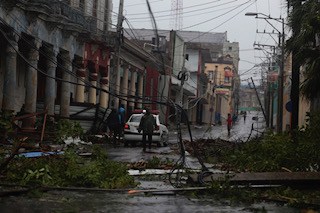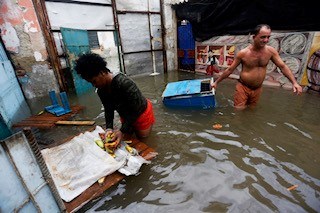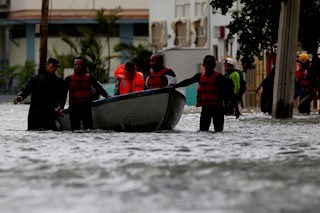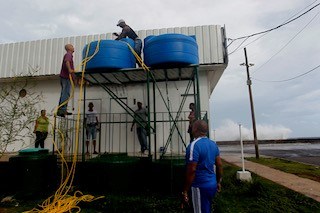Active Hurricane Season Highlights Cuba’s Vulnerabilities

HAVANA TIMES – The high probability of a hurricane hitting Cuba during the next cyclone season underscores the vulnerabilities and risks to the citizens, homes, and agriculture, as well as the necessary mitigation actions in a very unfavorable economic context.
“If a lot of buildings collapse with heavy rain, imagine what would happen if a hurricane hits. It would be a tragedy. When it rains here, the walls leak, and I fear the roof might collapse,” confessed Floraida Matos, a retired accountant living in an old building in Havana, in an interview with IPS.
One of the main vulnerabilities of this Caribbean island nation to heavy rainfall, tornadoes, and tropical cyclones lies in its housing stock, with one-third of the four million homes in fair or poor technical condition.
In Cuba’s cities, including Havana with its 2.2 million inhabitants, collapses of century-old buildings without repairs or rehabilitation work for decades are common after heavy rains.

Low-lying areas in Havana and other towns are also flooded after heavy rains or coastal flooding due to storm surges.
Many of the island’s cities urgently need investments in new sewage lines and drainage channels because “many are clogged due to improper road repairs, only sporadic cleaning of drains, or accumulated garbage and debris in the streets,” engineer Alexis Núñez told IPS.
Living in a low-lying area in Havana, Nuñez recalled that part of the drainage systems in the Cuban capital “are over 100 years old and collapse during heavy rains.”
The loss of crops and animals after the impact of a high-intensity hurricane would also pose a significant vulnerability for this Caribbean Island nation, which imports 70% to 80% of the food it consumes annually.
Amid a deep economic crisis, the island’s government faces difficulties importing food, fuel, and other supplies due to foreign currency shortages, obstacles to accessing credit due to the US embargo, and rising prices on the international market.
For Idania Reyes, a self-employed worker in Havana, the current inflationary context and marked depreciation of wages and pensions “make it difficult to buy non-perishable food” such as canned meat, eggs, cookies, jellies, and sweets.
Reyes told IPS that these foods are available in private shops and state-owned hard currency stores, “but they are very expensive, and not everyone, due to their low income, can buy enough to get through the cyclone and the following days without electricity.”
A minimum pension on the island is equivalent to about four dollars a month, and the average salary is just over 12 dollars, based on the informal foreign exchange market rate.
Forecasts
The hurricane season runs from June 1 to November 30 in the North Atlantic, Gulf of Mexico, and Caribbean Sea. A very active season is forecast for 2024, with the possible formation of 20 named tropical cyclones, 11 of which could become hurricanes.
According to the Meteorology Institute (Insmet), based in Havana, there is a 90% probability of a tropical storm impacting Cuba during these months and an 80% chance it will be a hurricane with maximum sustained winds of over 119 kilometers per hour.
The sea surface temperature in the tropical strip of the North Atlantic has shown high values from June 2023 to April 2024, and forecast models indicate that this warming could persist during the cyclone season and favorably influence the formation and development of tropical cyclones, warned specialists from Insmet’s Forecast and Climate Centers.

They added that another important factor is the El Niño – Southern Oscillation (ENSO) event, which is weakening, and most models predict it could end in May to transition to neutral conditions.
There is also a high probability that another event, La Niña – Southern Oscillation (AENOS), will develop in the coming months, which favors a very active cyclone season.
El Niño is an episode of warm winds over the central and eastern equatorial Pacific Ocean, altering rainfall and drought cycles in various regions of the planet. Its opposite phenomenon, with cold winds, is known as La Niña.
A report presented on May 8 by the World Meteorological Organization confirmed that 2023 was the warmest year ever recorded in Latin America and the Caribbean, with an average temperature 0.82 degrees Celsius above the 1991-2020 average.
It noted that, along with human-induced climate change, the 2023-2024 El Niño contributed to extreme heat worldwide and exacerbated numerous extreme phenomena and unprecedented marine heatwaves.
Such a combination affected health, food and energy security, and economic development, the report emphasized.
According to the report, last year, disasters and climate change damaged agriculture and food security in the region, placing 13.8 million people in acute food crisis situations, especially in Central America and the Caribbean.
The World Meteorological Organization also warned about the melting glaciers and the rapid rise of the sea level along the Atlantic coast of the region, threatening coastal areas and small island states in the Caribbean.
Improving Risk Management
Every year, tropical cyclones cause numerous casualties, deaths, and significant damage to property and infrastructure.
In 2023, one of the most extreme phenomena was the fierce Category 5 Hurricane Otis (the maximum on the Saffir-Simpson scale), which ravaged the city of Acapulco on the Mexican Pacific coast on October 25, with dozens of victims and billions of dollars in material damage.
In September 2017, Hurricane Irma and its powerful winds of up to 240 kilometers per hour crossed almost the entire north coast of Cuba, impacting 13 of the country’s 15 provinces, leaving 10 dead and causing severe damage to homes, agriculture, and key economic sectors.

In this regard, the World Meteorological Organization report emphasized the urgency of increasing investments in national meteorological and hydrological services to improve forecasts and early warnings to save lives.
The document stressed ensuring that all people and property are protected by early warning systems and the need to make alert schedules more flexible due to the rapid intensification processes increasingly experienced by tropical cyclones.
Studies recognize that adequate risk management and vulnerability reduction at the local level can mitigate the harmful impact of natural disasters, which must be accompanied by greater public education to raise awareness of the danger posed by extreme phenomena.
Among other strengths, Cuba has a Civil Defense system, organized from the national to the local level, to protect the population and the economy from exceptional situations such as hurricanes, tornadoes, floods, or chemical spills.
This system includes prevention, preparation, surveillance, early warning and danger forecasting, variable and risk assessment, and citizen warning and guidance.
Since 2022, a project has been underway to formulate an Adaptation Plan for the Coastal Zone of Havana, considering medium-term (2030) and long-term (2050) climate risks and specific vulnerabilities, integrating adaptation measures and investment decisions into the development planning process.
This initiative will impact a coastal strip 47 kilometers long, vulnerable to sea-level rise and extreme weather events, where more than 700,000 inhabitants, 37% of the capital’s population, live.
Funded by the Green Climate Fund, it will be implemented until June 2026 by the Environmental Agency of the Ministry of Science, Technology, and Environment, in partnership with the United Nations Development Program.
In December 2022, the Urban Resilience project also began, aimed at strengthening the preparedness capacities of the housing and urban planning sector in the municipality of Old Havana, to respond to the danger of collapses and reduce their impacts on the most vulnerable people, as well as to increase resilience.





